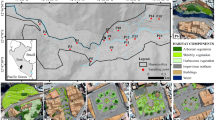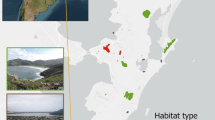Abstract
Cities are highly modified environments in which the only areas that resemble natural landscapes are urban parks with low human population density. Attempts are frequently made to maintain high bird diversity in cities for aesthetic or educational reasons. However, it remains unclear whether local site characteristics are important in determining bird assemblage composition or whether simplification of the assemblage is an inevitable consequence of the changes associated with human population density. From May 1998 to December 1999, we undertook bird counts at 521 points in Porto Alegre, Rio Grande do Sul, southern Brazil. Our main goal was to understand the pattern of distribution of the bird species richness and density within the city and determine which variables most affect species assemblages. We recorded 132 species belonging to 43 families that are common in Rio Grande do Sul and obtained quantitative data on 121 species in survey sites. The two most abundant species (House Sparrow, Passer domesticus and Rock dove, Columba livia) were exotics. Analysis based on a reduced subset of 134 points surveyed in spring/early summer suggested that there was a North–south gradient in assemblage structure. Variation in assemblage structure was also affected by the number of trees, urban noise and human population density. However, human population density had a much smaller effect on richness and assemblage structure than variables subject to management, such as tree density and noise levels. These results suggest that complex communities may be maintained in densely populated urban areas of sub-tropical South-America given adequate urban planning.





Similar content being viewed by others
References
Aleixo A (1999a) Effect of selective logging on bird community in Brazilian Atlantic Forest. Condor 101:537–548
Aleixo A (1999b) Effect of selective logging on bird community in Brazilian Atlantic Forest. Condor 101:537–548
Aleixo A, Vielliard JME (1995) Composição e dinâmica da avifauna da mata da Santa Genebra, Campinas, São Paulo, Brasil. Rev Bras Zool 12:493–511
Beissinger SR, Osborne DR (1982) Effect of urbanization on avian community organization. Condor 84:75–83
Belbin L (1992) PATN—Pattern Analysis Package. CSIRO, Australia
Belton W (1994) Aves do Rio Grande do Sul: distribuição e biologia. Unisinos, São Leopoldo
Bencke GA (2001) Lista de referência das aves do Rio Grande do Sul. Fundação Zoobotânica do Rio Grande do Sul, Porto Alegre
Bezzel E (1985) Birdlife in intensively used rural and urban environments. Ornis Fennica 62:90–95
Bibby CJ, Burgess ND, Hill DA (1992) Bird Census Techniques. Royal Society for the Protection of Birds, British trust for Ornithology, Academic Press and The University Press, Cambridge
Blair RB (1996) Land use and avian species diversity along an urban gradient. Ecol Appl 6:506–519
Brack P, Rodrigues RS, Sobral M et al (1998) Árvores e arbustos na vegetação natural de Porto Alegre, Rio Grande do Sul, Brasil. Iheringia 51:139–166
Cam EB, Nichols JD, Sauer JR et al (2000) Relative species richness and community completeness: birds and urbanization in the Mid-Atlantic States. Ecol Appl 10:1196–1210
Comitê Brasileiro de Registros Ornitológicos (2008) Lista de aves do Brasil. Version 10/02/2008. Available at: http://www.cbro.org.br. Accessed date 01/12/2008
Chace JF, Walsh JJ (2006) Urban effects on native avifauna: a review. Landscape Urban Plan 74:46–69
Clergeau P, Savard JP, Menechez G et al (1998) Bird abundace and diversity along an urban-rural gradient: a comparative study between two cities in different continents. Condor 45:413–425
Clergeau P, Croci S, Jokimäki J et al (2006a) Avifauna homogenisation by urbanisation: analysis at different European latitudes. Biol Conserv 127:336–344
Clergeau P, Croci S, Jokimäki J et al (2006b) Avifauna homogenisation by urbanisation: analysis at different European latitudes. Biol Conserv 127:336–344
Dias RA, Burger MI (2005) A assembléia de aves de áreas úmidas em dois sistemas de cultivo de arroz irrigado no extremo sul do Brasil. Revista Brasileira de Ornitologia 13:63–80
Emlen JT (1974) An urban bird community in Tucson, Arizona: derivation, structure, regulation. Condor 76:184–197. doi:10.2307/1366729
Erz W (1983) Ecological principles in the urbanization of birds. Ostrich Sup 6:357–363
Feninger O (1983) Estudios cuantitativos sobre aves em areas urbanas de Buenos Aires con densa poblacion humana. Hornero no. Extraordinário
Fontana CS (2004) Estrutura de uma comunidade urbana de aves: um experimento em Porto Alegre. PhD Pontifícia Universidade Católica do Rio Grande do Sul, Rio Grande do Sul
Fontana CS (2005) A ornitofauna em Porto Alegre no século XX: status de ocorrência e conservação Comun Mus Ciênc Tecnol PUCRS. Sér Zool 18:161–206
Franchin AG. (2009) Avifauna em áreas urbanas brasileiras, com ênfase em cidades do Triângulo Mineiro/Alto Paranaíba. Universidade Federal de Uberlândia
GUIA (1998) Guia das ruas de Porto Alegre: mapas e CEP de todo o município. Editora Globo, Porto Alegre
IBGE (2005) Instituto Brasileiro de Geografia e Estatística. Disponible at: http://www.ibge.gov.br
Jokimäki J, Kaisanlahti-Jokimäki MJ (2003) Spatial similarity of urban bird communities: a multiscale approach. J Biogeogr 30:1183–1193
Lancaster RK, Rees WE (1979) Bird communities and the structure of urban habitats. Can J Zool 57:2358–2368
Leveau LM, Leveau CM (2004) Comunidades de aves en un gradiente urbano de la ciudad de Mar del Plata, Argentina. Hornero 19:13–21
Leveau CM, Leveau LM (2005) Avian community response to urbanization in the pampeam region, Argentina. Ornitologia Neotrop 16:505–510
Lyle JT (1996) Cities of the future will embrace the ecology of the landscape, rather than set themselves apart. In: In Context
MacGregor-Fors I (2008) Relation between habitat atributes and bird richness in a western Mexico suburb. Landscape Urban Plan 84:92–98, http://www.elsevier.com/locate/landurbplan
Magurran AE (2005) Species abundance distributions: pattern or process? Funct Ecol 19:177–181
Martensen AC, Pimentel RG, Metzger JP (2008) Relative effects of fragment size and connectivity on bird community in the Atlantic Rain Forest: Implications for conservation. Biol Conserv 141:2184–2192
Marzluff JM, Bowman R, Donnely R (2001a) Avian ecology and conservation in an urbanizing world. Kluwer Academic Publishers, Norwell
Marzluff JM, Bowman R, Donnely R (2001b) A historical perspective on urban birds research: trends, terms and approaches. In: Marzluff JM, Bowman R, Donnelly R (eds) Avian ecology and conservation in an urbanizing world. Kluwer Academic Publishers, Norwell pp. 1–17
Matarazzo-Neuberger WM (1992) Avifauna urbana de dois municípios da grande São Paulo, SP (Brasil). Acta Biol Par 21:89–106
McKinney ML (2006) Urbanization as a major cause of biotic homogenization. Biol Conserv 127:247–260
Mendonça-Lima A, Fontana CS (2000) Composição, freqüência e aspectos biológicos da avifauna no Porto Alegre Country Clube, Rio Grande do Sul. Ararajuba 8:1–8
Menegat R, Porto ML, Carraro CC et al (1998) Atlas Ambiental de Porto Alegre. Editora da Universidade/UFRGS, Porto Alegre
Morneau F, Décarie R, Pelletier R et al (1999) Changes in breeding bird richness and abundance in Montreal parks over a period of 15 years. Landscape Urban Plan 44:11–121
Olden JD, Rooney TP (2006) On defining and quantifying biotic homogenization. Glob Ecol Biogeogr 15:113–120
Piratelli A, de Andrade VA, Lima-Filho M (2005) Aves de fragmentos florestais em área de cultivo de cana-de-açúcar no sudeste do Brasil. Iheringia Sér Zoologia 95:217–222
Platt A, Lill A (2006) Composition and conservation value of bird assemblages of urban “habitat islands”: Do pedestrian traffic and landscape variables exert an influence? Urban Ecosystem 9:83–97. doi:10.1007/s11252-006-7900-6
PPDUA (1999) Lei Complementar nº 434, de 1 de dezembro de 1999. Dispõe sobre o desenvolvimento urbano no Município de Porto Alegre, institui o Plano Diretor de Desenvolvimento Urbano Ambiental de Porto Alegre e dá outras providências. (ed Alegre DOdP). Prefeitura Municipal de Porto Alegre
Reynaud RA, Thioulouse J (2000) Identification of birds as ecological markers along a neotropical urban-rural gradient (Cayenne, French Guiana) using co-inertia analysis. J Environ Manage 59:121–140
Ruszczyk A (1984) Influência da urbanização na distribuição, abundância e diversidade das borboletas (LEPIDOPTERA) da cidade de Porto Alegre. Universidade Federal do Rio Grande do Sul, Brasil
Ruszczyk A (1986) Distribution and abundance of butterflies in the urbanization zones of Porto Alegre, Brazil. J Res Lepidoptera 25:157–178
Ruszczyk A, Rodrigues JJS, Roberts TMT et al (1987) Distribution patterns of eight bird species in the urbanization gradient of Porto Alegre, Brazil. Ciên Cult 39:14–19
Sanchotene MCC (2000) Plano diretor de Vias Públicas. Secretaria Municipal do Meio Ambiente, Porto Alegre
Savard JPL, Clergeau P, Mennechez G (2000) Biodiversity concepts and urban ecosystems. Landscape Urban Plan 48:131–142
Sekercioglu CH (2006) Increasing awareness of avian ecological function. Trends Ecol Evol 21:464–471. doi:10.1016/j.tree.2006.05.07
Sick H (1997) Ornitologia Brasileira. Nova Fronteira, Rio de Janeiro
Souza FL (1995) Avifauna da cidade de Ribeirão Preto, estado de São Paulo. Biotemas 8:100–109
SPSS SMD (2000) ISystat 10.0 StatisticsI,Computer Program
Torga K, Franchin AG, Marcal Junior O (2007) Avifauna in a section of the urban area of Uberlandia, MG. Biotemas 20:7–17
UNFPA (2007) State of World Population 2007: Unleasing the Potential of Urban Growth. United Nations Population Fund
United N (2006) Population division of the Departament of Economic and Social Affairs of the United Nations Secretariat, World Population Prospects: The 2006 Revision and World Urbanization Prospects: The 2007 Revision. United Nations
Valadão RM, Marcal Junior O, Franchin AG (2006) The avifauna in the Santa Luzia Municipal Park, urban zone of the municipality of Uberlandia, State of Minas Gerais. Biosci J 22:97–108
Voss WA (1979a) Aves de Porto Alegre, RS: I- aves observadas na área central da cidade. Pesquisas 1–7
Voss WA (1979b) Aves observadas na área central da cidade de São Leopoldo, RS. Pesquisas 9–24
Willis EO (1979) The composition of avian communities in remanescent woodlots in southern Brazil. Papéis Avulsos Zoologia 33:1–25
Willis EO, Oniki Y (1981) Levantamento preliminar de aves em treze áreas do Estado de São Paulo. Revta Bras Biol 41:121–135
Acknowledgments
We thank André de Mendonça−Lima and Cristian Joenck for help in the field. Roberto Reis and Juliana Bosi de Almeida gave a valuable help with the first English version. Clarissa Fontana and Luciane Salvi helped format the figures. We thank Andreas Kindel, Luis dos Anjos, Helena Romanowisky and Márcio Martins for their valuable suggestions on CSF dissertation and Walter Voss and Márcio Repenning for bibliography and improvement of the manuscript. Lucio Lucateli and Henrich Hasenack, from Idrisi Resource Study Center (UFRGS), did the map of Fig. 1. Museu de Ciências e Tecnologia—Pontifícia Universidade Católica do Rio Grande do Sul (PUCRS), Fundação Zoobotânica do Rio Grande do Sul (FZBRS), and Instituto Nacional de Pesquisas da Amazonia (INPA) provided logistical support. Secretariate of Urban Planning provided data on Porto Alegre Census Sectors. This work was partially supported by a CNPq fellowship to Carla Suertegaray Fontana (1998).
Author information
Authors and Affiliations
Corresponding author
Appendix
Appendix
Rights and permissions
About this article
Cite this article
Fontana, C.S., Burger, M.I. & Magnusson, W.E. Bird diversity in a subtropical South-American City: effects of noise levels, arborisation and human population density. Urban Ecosyst 14, 341–360 (2011). https://doi.org/10.1007/s11252-011-0156-9
Published:
Issue Date:
DOI: https://doi.org/10.1007/s11252-011-0156-9




